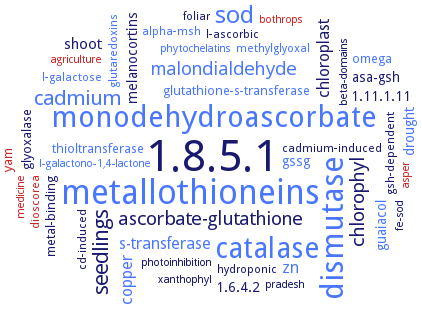1.8.5.1: glutathione dehydrogenase (ascorbate)
This is an abbreviated version!
For detailed information about glutathione dehydrogenase (ascorbate), go to the full flat file.

Word Map on EC 1.8.5.1 
-
1.8.5.1
-
metallothioneins
-
dismutase
-
monodehydroascorbate
-
catalase
-
sod
-
seedlings
-
cadmium
-
chlorophyl
-
ascorbate-glutathione
-
malondialdehyde
-
s-transferase
-
chloroplast
-
zn
-
copper
-
shoot
-
1.6.4.2
-
asa-gsh
-
drought
-
1.11.1.11
-
gssg
-
melanocortins
-
guaiacol
-
glyoxalase
-
omega
-
metal-binding
-
glutathione-s-transferase
-
thioltransferase
-
yam
-
l-galactose
-
cadmium-induced
-
dioscorea
-
l-ascorbic
-
foliar
-
gsh-dependent
-
methylglyoxal
-
alpha-msh
-
cd-induced
-
hydroponic
-
glutaredoxins
-
l-galactono-1,4-lactone
-
bothrops
-
xanthophyl
-
pradesh
-
medicine
-
agriculture
-
photoinhibition
-
fe-sod
-
phytochelatins
-
asper
-
beta-domains
- 1.8.5.1
- metallothioneins
- dismutase
- monodehydroascorbate
- catalase
- sod
- seedlings
- cadmium
-
chlorophyl
-
ascorbate-glutathione
- malondialdehyde
- s-transferase
- chloroplast
- zn
- copper
- shoot
-
1.6.4.2
-
asa-gsh
- drought
-
1.11.1.11
- gssg
-
melanocortins
- guaiacol
- glyoxalase
- omega
-
metal-binding
- glutathione-s-transferase
- thioltransferase
- yam
- l-galactose
-
cadmium-induced
- dioscorea
-
l-ascorbic
-
foliar
-
gsh-dependent
- methylglyoxal
- alpha-msh
-
cd-induced
-
hydroponic
- glutaredoxins
- l-galactono-1,4-lactone
- bothrops
-
xanthophyl
-
pradesh
- medicine
- agriculture
-
photoinhibition
- fe-sod
- phytochelatins
- asper
-
beta-domains
Reaction
2 glutathione
+
Synonyms
At1g19570, At1g75270, At5g16710, AtDHAR, AtDHAR1, AtDHAR2, AtDHAR3, CrDHAR1, DasA reductase, dehydroascorbate reductase, dehydroascorbate reductase 2, dehydroascorbic acid reductase, dehydroascorbic reductase, dehydrogenase, glutathione (ascorbate), DHA reductase, DHA-R, DHAR, DHAR1, DHAR2, DHAR3, DHAR3a, DHAR4, DHAR5, dioscorin, GDOR, glutathione dehydroascorbate reductase, glutathione-dependent dehydroascorate reductase, glutathione:dehydroascorbic acid oxidoreductase, GRX1, GRX2, GSH-DHAR, GSH:DHA-oxidoreductase, GSTO, GSTO1, GSTO1-1, GSTO2, GSTO2-2, LcDHAR, metallothionein-1, metallothionein-2, More, MT-I, MT-II, nlGSTO, OsDHAR, OsDHAR1, PbDHAR, PgDHAR1, PtrDHAR1, PtrDHAR2, PtrDHAR3A, PtrDHAR3B, SPD1


 results (
results ( results (
results ( top
top






